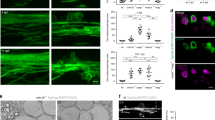Abstract
The cell adhesion molecule isolated from neural tissue (N-CAM) is a membrane glycoprotein which is directly involved in calcium-independent adhesion among nerve cells and their processes (for review see refs 1,2). N-CAM has an unusual carbohydrate moiety containing a large and variable amount of sialic acid, the variation reflecting both the type of tissue and its developmental age3,4. N-CAM is believed to be a ligand in the formation of cell-cell bonds5 and a decrease in sialic acid content from 30% to 10% is associated with a marked enhancement of the molecule's binding activity6–8. Antibodies to N-CAM block its function and inhibit or alter bundling of nerve fibres9, retinal cell development10–12 and nerve-muscle interaction13,14. Here we use micro-gel elec-trophoresis15 to compare N-CAM from several parts of the developing chick visual system. The results indicate that N-CAM from the retina of 5–10-day-old embryos already exists in a relatively sialic acid-poor form, whereas the tectum and optic nerve beyond the eye contain sialic acid-rich N-CAM until much later in development. These studies suggest that the perikaryon and proximal axon shaft of retinoganglion cells have N-CAM with a lower sialic acid content than the distal portion of the axons, and that resulting differences in neurite adhesivity may be an important factor in the formation of the optic system.
This is a preview of subscription content, access via your institution
Access options
Subscribe to this journal
Receive 51 print issues and online access
$199.00 per year
only $3.90 per issue
Buy this article
- Purchase on Springer Link
- Instant access to full article PDF
Prices may be subject to local taxes which are calculated during checkout
Similar content being viewed by others
References
Rutishauser, U. Cold Spring Harb. Symp. quant. Biol. 48, 501–514 (1983).
Edelman, G. M., Hoffman, S. & Cunningham, B. A. Cold Spring Harb. Symp. quant. Biol 48, 515–526 (1983).
Hoffman, S. et al. J. biol. Chem. 257, 7720–7729 (1982).
Rothbard, J. B., Brackenbury, R., Cunningham, B. A. & Edelman, G. M. J. biol. Chem. 257, 11064–11069 (1982).
Rutishauser, U., Hoffman, S. & Edelman, G. M. Proc. natn. Acad. Sci. U.S.A. 79, 685–689 (1982).
Cunningham, B. A., Hoffman, S., Rutishauser, U., Hemperly, J. J. & Edelman, G. M. Proc. natn. Acad. Sci. U.S.A. 80, 3116–3120 (1983).
Hoffman, S. & Edelman, G. M. Proc. natn. Acad. Sci. U.S.A. 80, 5762–5766 (1983).
Sadoul, R., Hirn, M., Deagostini-Bazin, H., Rougon, G. & Goridis, C. Nature 304, 347–349 (1983).
Rutishauser, U., Gall, W. E. & Edelman, G. M. J. Cell Biol. 79, 382–393 (1978).
Rutishauser, U., Thiery, J.-P., Brackenbury, R. & Edelman, G. M. J. Cell Biol. 79, 371–381 (1978).
Buskirk, D. R., Thiery, J.-P., Rutishauser, U. & Edelman, G. M. Nature 285, 488–489 (1980).
Thanos, S., Bonhoeffer, F. & Rutishauser, U. Proc. natn. Acad. Sci. U.S.A. 81, 1906–1910 (1984).
Grumet, M., Rutishauser, U. & Edelman, G. M. Nature 295, 693–695 (1982).
Rutishauser, U., Grumet, M. & Edelman, G. M. J. Cell Biol. 97, 145–152 (1983).
Neukirchen, R. O., Schlosshauer, B., Baars, S., Jackle, H. & Schwarz, U. J. biol. Chem. 257, 15229–15234 (1982).
Rager, G. H. Development of Retinotectal Projection in the Chicken (Springer, Berlin, 1980).
Towbin, H., Staehlin, T. & Gordon, J. Proc. natn. Acad. Sci. U.S.A. 76, 4350–4354 (1979).
Edelman, G. M. & Choung, C.-M. Proc. natn. Acad. Sci. U.S.A. 79, 7036–7040 (1982).
Halfter, W., Claviez, M. & Schwarz, U. Nature 292, 67–70 (1981).
Halfter, W., Newgreen, D. F., Sauter, J. & Schwarz, U. Devl Biol. 95, 56–64 (1983).
Hawkes, R., Niday, E. & Gordon, J. Analyt. Biochem. 119, 142–147 (1982).
Author information
Authors and Affiliations
Rights and permissions
About this article
Cite this article
Schlosshauer, B., Schwarz, U. & Rutishauser, U. Topological distribution of different forms of neural cell adhesion molecule in the developing chick visual system. Nature 310, 141–143 (1984). https://doi.org/10.1038/310141a0
Received:
Accepted:
Issue Date:
DOI: https://doi.org/10.1038/310141a0
This article is cited by
-
Ninjurin1: a Potential Adhesion Molecule and Its Role in Inflammation and Tissue Remodeling
Molecules and Cells (2010)
-
Ninjurin1 mediates macrophage-induced programmed cell death during early ocular development
Cell Death & Differentiation (2009)
-
Neural cell adhesion molecule (NCAM) as a quantitative marker in synaptic remodeling
Neurochemical Research (1995)
-
Distribution of NCAM-180 and polysialic acid in the developing tectum mesencephali of the frog Discoglossus pictus and the salamander Pleurodeles waltl
Cell and Tissue Research (1993)
-
Expression of highly polysialylated NCAM in the neocortex and piriform cortex of the developing and the adult rat
Anatomy and Embryology (1991)
Comments
By submitting a comment you agree to abide by our Terms and Community Guidelines. If you find something abusive or that does not comply with our terms or guidelines please flag it as inappropriate.



